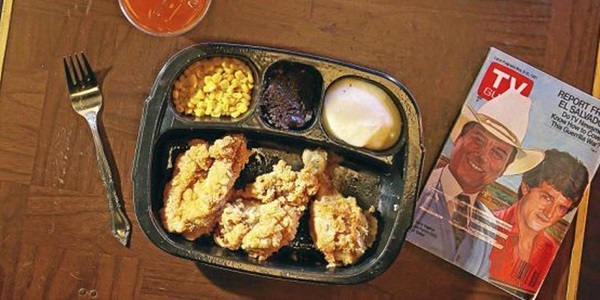National TV Dinner Day is celebrated on September 10. It honors TV Dinners, allowing You to enjoy a full meal without cooking. It’s a perfect day to watch TV while eating. The first TV Dinner by C.A. Swanson & Sons in 1953 was a Thanksgiving meal with turkey, peas, cornbread dressing, and sweet potatoes.
History of National TV Dinner Day
As television became more popular, families started gathering around it for entertainment. The idea of the TV dinner was created to enhance this experience.
Initially called the TV Brand Frozen Dinner, TV dinners gained popularity in the 1950s. Long before TV dinners became popular, frozen meat was already common, but early freezing methods made the food lose its flavor and taste, limiting its appeal.
The development of frozen foods was significantly advanced by Clarence Birdseye, who discovered a quick and effective way to freeze fish in 1925.
He later applied this method to vegetables. During World War II, this freezing process was used to supply food to the military. In 1949, Albert and Meyer Bernstein introduced TV dinners to a larger market by founding Frozen Dinners Inc. and selling their products in the Pittsburgh area.

However, TV dinners took off when C.A. Swanson and Sons revamped the concept. With this new approach, TV dinners quickly gained popularity. The original idea is attributed to Gerry Thomas, a Swanson salesman. After poor Thanksgiving sales left them with extra turkey, Thomas reportedly came up with the TV dinner concept to use up the leftovers.
Today, TV dinners offer various foods, including fruits and vegetables. National TV Dinner Day celebrates the convenience of enjoying a meal while relaxing in front of the TV.
| 1925 (Improved Methods for Freezing Food) | Clarence Birdseye develops an effective method of freezing fish. |
| 1944 (Useful During the War) | Using Clarence Birdseye’s method, Maxson Food Systems Inc. is able to make frozen dinners for the military and civil air carriers. |
| 1953 (First TV Dinner) | C.A. Swanson and Sons came up with the idea of a TV dinner after they were left with tons of leftover turkey. |
| 1986 (Trays for Microwaves) | Trays that adapt to microwaves are invented for the purpose of TV dinners. |
5 Interesting Facts About TV Dinner
Popularized by TV: The concept of the TV dinner was closely linked to watching TV, as families would often enjoy these meals together in front of the television.
Affordable: TV dinners are typically inexpensive, making them a convenient and cost-effective meal option.
Hungry-Man Dinners: For those with bigger appetites, Hungry-Man dinners offer larger portions with more food on bigger trays.
Instant Success: In just their third year, C.A. Swanson and Sons sold 25 million TV dinners, marking an immediate hit.
Wide Range of Options: TV dinners come in a variety of choices, catering to different tastes and preferences.
Cultural Impact and Popularity
The TV dinner’s impact on American culture was profound. It not only changed how people prepared and consumed food but also reflected broader societal changes. As television became a central part of American life, the TV dinner became a symbol of modernity and convenience.
During the 1950s and 1960s, the TV dinner was a symbol of the American Dream, representing progress and innovation. It was featured in popular media and became a cultural touchstone. Families would gather around the television to watch shows, and the TV dinner became a part of this ritual, making mealtime a more relaxed and informal experience.
The convenience of TV dinners also contributed to the rise of other frozen and pre-packaged foods, transforming the food industry. By the 1960s, TV dinners had become a household staple, with various flavors and meals added to cater to different tastes.
Conclusion
National TV Dinner Day on September 10 celebrates the convenience and cultural impact of TV dinners, which began with a Thanksgiving meal from C.A. Swanson & Sons in 1953. Once a symbol of modern convenience, TV dinners have evolved into a staple of American food culture. Honoring this day highlights the innovation behind a meal that combines ease and nostalgia, reflecting broader changes in how we eat and entertain ourselves.
Frequently Ask Question
1. What is National TV Dinner Day?
National TV Dinner Day is celebrated on September 10 each year to honor the convenience and innovation of TV dinners. It’s a day to enjoy a full meal while watching TV, celebrating a meal that combines ease with nostalgia.
2. When was the first TV dinner created?
The first TV dinner was created by C.A. Swanson & Sons in 1953. It was a Thanksgiving meal consisting of turkey, peas, cornbread dressing, and sweet potatoes.
3. Who invented the TV dinner?
While the concept of TV dinners was popularized by C.A. Swanson & Sons, the idea is attributed to Gerry Thomas, a Swanson salesman. He came up with the concept to use up leftover turkey after poor Thanksgiving sales.
4. What was the role of Clarence Birdseye in the development of TV dinners?
Clarence Birdseye significantly advanced the frozen food industry by developing an effective method of freezing fish in 1925. His method was later applied to vegetables and contributed to the development of frozen dinners.
5. How did TV dinners impact American culture?
TV dinners became a symbol of modern convenience and innovation in the 1950s and 1960s. They transformed mealtime, making it a more relaxed and informal experience, and influenced the rise of other frozen and pre-packaged foods.
Also read, International Bacon Day – September 7, 2024
